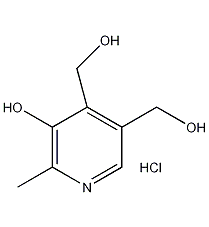
Structural formula
| Business number | 019K |
|---|---|
| Molecular formula | C8H11NO3·HCl |
| Molecular weight | 205.64 |
| label |
5-hydroxy-6-methyl-3,4-pyridine dimethanol hydrochloride, Adermine hydrochloride, PN HCl, Biochemical reagents |
Numbering system
CAS number:58-56-0
MDL number:MFCD00012807
EINECS number:200-386-2
RTECS number:UV1350000
BRN number:3632435
PubChem number:24899059
Physical property data
1. Properties: white crystal or crystalline powder. Odorless. The taste is slightly salty and bitter. It gradually deteriorates when exposed to light. Stable in air.
2. Density (g/mL, 25/4℃): Undetermined
3. Relative vapor density (g/mL, air=1): Undetermined
4. Melting point (ºC): 205~212℃ (decomposition and sublimation).
5. Boiling point (ºC, normal pressure): Undetermined
6. Boiling point (ºC): 140-150℃ (1.33×10-5kPa)
7. Refractive index: Undetermined
8. Flash point (ºC): Undetermined
9. Specific rotation (º): Undetermined
10. Autoignition point or ignition temperature (ºC): Undetermined
11. Vapor pressure (kPa, 25ºC): Undetermined
12. Saturated vapor pressure (kPa, 60ºC) : Undetermined
13. Heat of combustion (KJ/mol): Undetermined
14. Critical temperature (ºC): Undetermined
15. Critical pressure (KPa): Undetermined
16. Log value of oil-water (octanol/water) partition coefficient: Undetermined
17. Explosion upper limit (%, V/V): Undetermined Determined
18. Lower explosion limit (%, V/V): Undetermined
19. Solubility: 1g product is soluble in about 4.5ml water, 90ml ethanol, slightly soluble in acetone , insoluble in ether and chloroform.
Toxicological data
None
Ecological data
None
Molecular structure data
5. Molecular property data:
1. Molar refractive index: 43.95
2. Molar volume (cm3/mol): 124.9
3. Isotonic specific volume (90.2K): 361.1
4. Surface tension (dyne/cm): 69.7
5. Polarizability (10-24cm3): 17.42
Compute chemical data
1. Reference value for hydrophobic parameter calculation (XlogP):
2. Number of hydrogen bond donors: 4
3. Number of hydrogen bond acceptors: 4
4. Number of rotatable chemical bonds: 2
5. Number of tautomers: 3
6. Topological molecular polar surface area (TPSA): 73.6
7. Number of heavy atoms: 13
8. Surface charge: 0
9. Complexity: 142
10. Number of isotope atoms: 0
11. Determine the number of atomic stereocenters: 0
12. Uncertain number of atomic stereocenters: 0
13. Determine the number of chemical bond stereocenters: 0
14. Number of uncertain chemical bond stereocenters: 0
15. Number of covalent bond units: 2
Properties and stability
Stable under normal temperature and pressure
Storage method
This product should be sealed and stored in a cool, dry place away from light.
Synthesis method
1. Prepared by the reaction of alanine ethyl ester with formic acid acetic anhydride and condensation with fumaronitrile.
2.Use alanine as raw material through esterification, formamidation, condensation, and dehydration to form a salt to obtain the finished product. Vitamin B6 is obtained by esterification of α-aminopropionic acid with ethanol, amidation, catalytic ring closure, and reaction with isobutyl methacrylate.
3.Using alanine as raw material through esterification, carboxamidation, condensation and dehydration to form Salt is the finished product.
Purpose
1. Biochemical research. Mainly used in medicine, or further synthesized into drugs such as pyridoxal phosphate and cerebrospinal fluid. It is also used as a feed additive, food additive, and as a UV absorber in cosmetics. .
2.Vitamin B6 is found in general animal and plant foods, especially egg yolks, meat, and fish Vitamin B6 is relatively abundant in vitamins, milk and various cereals, and can be synthesized by human intestinal bacteria, so vitamin B6 deficiency generally does not occur. Our country stipulates that vitamin B6 can be used to fortify solid beverages, with a maximum dosage of 7 to 10mg/kg; in fortified infant and young child foods, the maximum dosage is 3 to 4mg/kg; the maximum usage amount in fortified beverages is 1 to 2mg/kg .
3.Used as a feed nutritional fortifier, it can promote the metabolism of amino acids in animals and improve feed utilization. The general dosage is 3 to 6 mg/kg.
4.Most of them are used as medicine or for further synthesis of drugs such as pyridoxal phosphate and cerebroxin, and are also used as feed additives , Food additives [The amount added to modified milk powder is 0.1mg · (100g) -1. Adults need 1.5~2mg per day. It is also used in cosmetics as a nutritional additive and ultraviolet absorber.

 微信扫一扫打赏
微信扫一扫打赏

